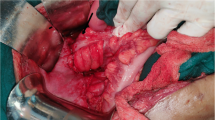Abstract
Background
Optimal surgical treatment for small early rectal carcinoids is controversial. Large tumors (greater than 2 cm) and those with imaging evidence of lymph node metastasis are generally treated by low anterior resection (LAR) with total mesorectal excision (TME). We first observed and reported that midgut carcinoid with extensive mesenteric lymphadenopathy often develops alternated lymphatic drainage pathways. We hypothesize that rectal carcinoids have the same potential to develop alternated lymphatic pathways outside the mesorectal envelope, which allows tumor deposits to be missed by traditional TME.
Methods
Twenty-two consecutive rectal carcinoid surgical patient charts were reviewed to determine if alternated lymphatic drainage occurred and resulted in extra-mesorectal metastasis. We attempted to identify any risk factor(s) that may lead to developing such alternated lymphatic drainage pathways.
Results
Thirteen patients underwent initial LAR with TME (13/22, 59 %) and nine underwent a staged debulking for locoregional residual disease or regional/distant metastasis after previous resection (9/22, 41 %). Fourteen (14/22, 64 %) underwent radio-guided surgery in attempt to achieve a higher level of pelvic/distant metastatic disease detection and debulking. Six patients (6/22, 27 %) had obturator canal lymph node metastases confirmed histologically.
Conclusions
Based on our study, at least 27 % of rectal carcinoid patients may have extra-mesorectal metastasis that would be missed by the traditional TME. Radio-guided surgery can identify and remove such metastasis. The effect of having such extra-mesorectal metastasis and its surgical removal on long-term survival has yet to be determined.


Similar content being viewed by others
References
Yao JC, Hassan M, Phan A, Dagohoy C, Leary C, Mares JE, Abdalla EK, Fleming JB, Vauthey JN, Rashid A, Evans DB. One Hundred Years After “Carcinoid”: Epidemiology of and Prognostic Factors for Neuroendocrine Tumors in 35,825 Cases in the United States. J Clin Oncol 2008;26:3063–3072.
Scherübl H. Rectal carcinoids are on the rise: early detection by screening endoscopy. Endoscopy 2009; 41:162–5.
Avenel P, McKendrick A, Silapaswan S, Kolachalam R, Kestenberg W, Ferguson L, Jacobs MJ, Goriel Y, Mittal V. Gastrointestinal carcinoids: an increasing incidence of rectal distribution. Am Surg 2010; 76:759–63.
Wang M, Peng J, Yang W, Chen W, Mo S, Cai S. Prognostic analysis for carcinoid tumours of recrectum: a single institutional analysis of 106 patients. Colorectal Dis 2011; 13:150–3.
Ramage JK, Goretzki PE, Manfredi R, Komminoth P, Ferone D, Hyrdel R, Kaltsas G, Kelestimur F, Kvols L, Scoazec JY, Sevilla Garcia MI, Caplin ME. Consensus guidelines for the management of patients with digestive neuroendocrine tumours: well-differentiated colon and rectum tumour/carcinoma. Neuroendocrinology 2008; 87:31–9.
Anthony LB, Strosberg JR, Klimstra DS, Maple WJ, O’Dorisio TM, Warner RR, Wiseman GA, Benson AB, Pommier RF. The NANETS consensus guidelines for the diagnosis and management of gastrointestinal neuroendocrine tumors (nets): well-differentiated nets of the distal colon and rectum. Pancreas 2010; 39:767–74.
National Cancer Institute (2011). Treatment guidelines for health care professionals. Available:http://www.cancer.gov/cancertopics/pdq/treatment/gastrointestinalcarcinoid/Patient/page1/AllPages/Print.
Kulke MH, Benson AB, Bergsland E, Berlin JD, Blaszkowsky LS, Choti MA, Clard OH, Doherty GM, Eason J, Emerson L, Engstrom PF, Goldner WS, Heslin MJ, Kandeel F, Kunz PM, Kuvshinoff BW, Moley JF, Pillarisetty VG, Saltz L, Schteingart DE. Neuroendocrine Tumors. J Natl Compr Canc Netw 2012; 10:724–64.
Modlin IM, Kidd M, Latich I, Zikusoka MN, Shapiro MD. Current status of gastrointestinal carcinoids. Gastroenterology 2005; 128:1717–51.
Modlin IM, Lye KD, Kidd M. A 5-decade analysis of 13,715 carcinoid tumors. Cancer 2003; 97:934–59.
Wang YZ, Joseph S, Lindholm E, Lyons J, Boudreaux JP, Woltering EA. Lymphatic mapping helps to define resection margins for midgut carcinoids. Surgery 2009; 146:993–7.
Wang YZ, Diebold A, Woltering E, King H, Boudreaux JP, Anthony LB, Campeau R. Radioguided exploration facilitates surgical cytoreduction of neuroendocrine tumors. J Gastrointest Surg 2012; 16:635–40.
Onogawa S, Tanaka S, Kitadai Y, Sumii M, Yoshihara M, Shimamoto F, Haruma K, Chayama K. Small rectal carcinoid with lymph node metastasis diagnosed prior to treatment. Eur J Gastroenterol Hepatol 2003; 15:195–7.
Banzo J, Vidal-Sicat S, Prats E, Galofre G, Razola P, Mane S, Ubieto MA, Abos MD. In 111 DTPA octreotide scintigraphy and intraoperative gamma probe detection in the diagnosis and treatment of residual lymph node metastases of a rectal carcinoid tumor. Clin Nucl Med 2005; 30:308–11.
Fahy BN, Tang LH, Klimstra D, Wong WD, Guillem JG, Paty PB, Temple LK, Shia J, Weiser MR. Carcinoid of the rectum risk stratification (CaRRS): a strategy for preoperative outcome assessment. Ann Surg Oncol 2007; 14:396–404.
Ueno H, Mochizuki H, Hashiguchi Y, Ishiguro M, Miyoshi M, Kajiwara Y, Sato T, Shimazaki H, Hase K. Potential prognostic benefit of lateral pelvic node dissection for rectal cancer located below the peritoneal reflection. Ann Surg 2007; 245:80–7
Sato H, Maeda K, Maruta M, Masumori K, Koide Y. Who can get the beneficial effect from lateral lymph node dissection for Dukes C rectal carcinoma below the peritoneal reflection? Dis Colon Rectum 2006; 49:S3-12.
Wang C, Zhou ZG, Yu YY, Li Y, Lei WZ, Cheng Z, Chen ZX. Patterns of lateral pelvic lymph node metastases and micrometastases for patients with lower rectal cancer. Eur J Surg Oncol 2007; 33:463–7.
Takahashi T, Ueno M, Azekura K, Ohta H. Lateral node dissection and total mesorectal excision for rectal cancer. Dis Colon Rectum 2000; 43:S59-68.
Suzuki K, Muto T, Sawada T. Prevention of local recurrence by extended lymphadenectomy for rectal cancer. Surg Today 1995; 25:795–801.
Yamaguchi T, Fujita S. A case of lateral pelvic lymph node recurrence of rectal carcinoid. Jpn J Clin Oncol 2008; 38:390.
Kwaan MR, Goldberg JE, Bleday R. Rectal carcinoid tumors: review of results after endoscopic and surgical therapy. Arch Surg 2008; 143:471–5.
Author information
Authors and Affiliations
Corresponding author
Ethics declarations
Financial Support
None to disclose.
Rights and permissions
About this article
Cite this article
Wang, YZ., Beyer, D.T. & Hall, M. Obturator Canal Lymph Node Metastasis from Rectal Carcinoid Tumors: Total Mesorectal Excision May Be Insufficient. J Gastrointest Surg 20, 1247–1252 (2016). https://doi.org/10.1007/s11605-016-3128-9
Received:
Accepted:
Published:
Issue Date:
DOI: https://doi.org/10.1007/s11605-016-3128-9




